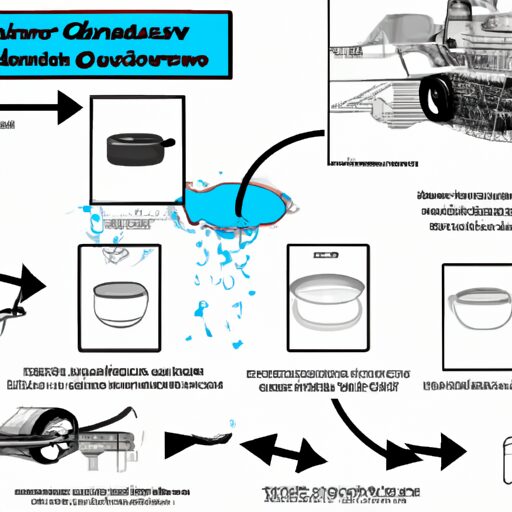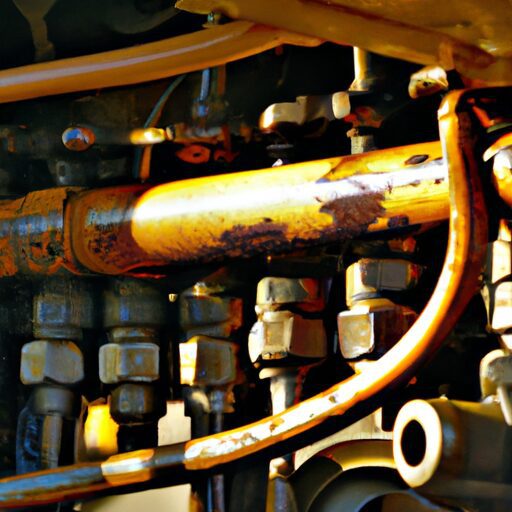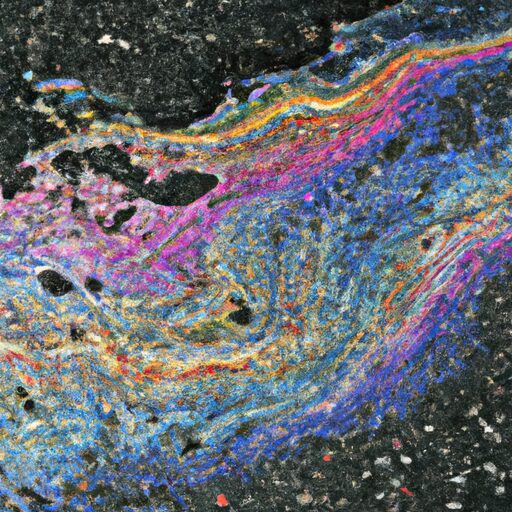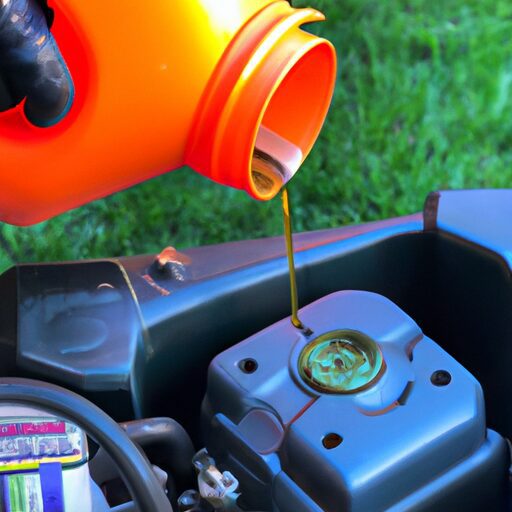How to Clean Hydraulic Fluid Off Concrete: 5 Effective Methods
Spilled hydraulic fluid or oil stains on concrete? Don’t panic, but act fast! Neglecting this excess oil situation can lead to serious consequences. Leaving hydraulic fluid or oil stains on concrete not only poses hazards but also risks damaging the surface. So, how do you tackle these slippery messes effectively? Use liquid detergent to clean up leaks.
Promptly cleaning up hydraulic fluid spills, excess oil, is crucial. The longer it lingers, the more it seeps into the porous concrete, making removal of leaks increasingly difficult. Ignoring it could result in unsightly stains or even compromise the structural integrity of your flooring. To clean up the spills, use liquid detergent and asphalt.
But fear not! There are various methods and techniques at your disposal for effective cleanup. From absorbent materials like cat litter to specialized cleaners for oil stains, we’ll explore these options to help you swiftly restore your concrete surface. You can rinse the area with liquid detergent to bring it back to its former glory.
Don’t let oil stains from hydraulic fluid spills leave a lasting mark on your concrete or asphalt. In the following sections, we’ll delve into why prompt action matters and guide you through the best approaches for rinsing and removing this troublesome substance.
Let’s get started!
Effective Methods to Remove Hydraulic Fluid From Concrete
Using Absorbent Materials
One effective method to remove oil stains from an asphalt floor is to use absorbent materials such as cat litter or sawdust. These materials are excellent at soaking up fresh spills and preventing the fluid from seeping deeper into the concrete surface. To clean the floor, simply rinse with water.
To begin, quickly grab a generous amount of cat litter or sawdust and spread it over the oil stains on the floor. Make sure to cover the entire spill with a thick layer. Allow the absorbent material to sit on the fluid for at least 15 minutes, giving it ample time to work its magic.
Once enough time has passed, use a stiff-bristle brush or broom to sweep away the now-clumped cat litter. Dispose of it properly according to local regulations. This method should effectively remove most of the oil stains from your asphalt floor.
Applying Pressure Washing
For more stubborn hydraulic fluid stains on concrete surfaces, pressure washing with asphalt can be a highly effective solution. A pressure washer utilizes high-pressure water jets that can penetrate deep into porous concrete and dislodge even the toughest stains. Additionally, using cat litter as a source of absorption before pressure washing can help to further remove v4 stains.
To start, ensure you have access to a pressure washer with an appropriate nozzle for cleaning concrete surfaces. Begin by thoroughly wetting down the oil stains with plain water. Then, using steady strokes, direct the pressure washer’s stream across the asphalt, focusing on one small section at a time. Use cat litter as a source for absorbing the oil stains.
Move systematically across the entire area affected by oil stains, ensuring that each section receives sufficient attention. Pay extra attention to any particularly stubborn oil spots by holding the nozzle closer and applying slightly more pressure.
After completing this process, inspect your concrete and asphalt surface for any remaining traces of hydraulic fluid stains. If necessary, repeat these steps until all signs of staining from litter have been eliminated.
Utilizing Environmentally Friendly Cleaners and Degreasers
In addition to traditional methods like absorbent materials and pressure washing, utilizing environmentally friendly cleaners and degreasers can provide a safe and effective cleanup solution for hydraulic fluid stains on asphalt. These methods help remove litter from the source and are compatible with v4 standards.
Look for eco-friendly cleaners and degreasers that are specifically designed to remove oil-based substances from asphalt surfaces without causing harm to the environment or compromising the integrity of your v4 concrete.
When using environmentally friendly cleaners, follow the instructions provided by the manufacturer. Typically, you will need to dilute the product with water before applying it to the stained area. Use a scrub brush or broom to work the cleaner into the stain, ensuring thorough coverage. Make sure to obtain the cleaner from a reliable source and check its license.
Allow the cleaner to sit on the stain for a recommended amount of time (usually specified on the product label) to fully penetrate and effectively remove the source of the stain. Then, rinse off the area with clean water until all traces of cleaner, as well as the stain’s source, have been completely removed.
By following these methods – using absorbent materials, applying pressure washing, and utilizing environmentally friendly cleaners and degreasers – you can effectively remove hydraulic fluid stains from your asphalt surfaces. Remember to always prioritize safety and choose methods that align with your environmental values.
Using Concrete Cleaner or Degreaser
Using a specialized concrete cleaner or degreaser can be highly beneficial for removing tough stains and breaking down the oil-based properties of hydraulic fluid on asphalt surfaces. These products, such as v4, are specifically formulated for optimal results. By following the right steps, you can achieve effective cleaning in no time at your desired location in Jan.
To begin, it is important to choose the right cleaner or degreaser for your asphalt needs. Look for products that are designed specifically for asphalt surfaces and have a proven track record of effectiveness in removing hydraulic fluid stains. Some recommended brands for asphalt cleaning include [Brand A], [Brand B], and [Brand C].
Once you have your chosen cleaner or degreaser, follow these steps for proper application on asphalt in v4 location in Jan.
- Prepare the v4 asphalt location: Before applying the cleaner in jan, make sure to remove any loose debris or dirt from the affected area. This can be done by sweeping or using a pressure washer on a low setting.
- Apply the asphalt cleaner: Follow the instructions provided by the manufacturer and apply the v4 cleaner evenly over the stained area. Use a brush with stiff bristles to scrub the cleaner into the concrete surface.
- Let it sit: Allow the v4 cleaner to penetrate and work its magic on the asphalt hydraulic fluid stain for a recommended amount of time (usually around 10-15 minutes). This will help loosen up and dissolve the stain.
- Scrub vigorously: After letting the asphalt sit, use a scrub brush or broom with firm bristles to scrub away at the v4 stain. Apply some extra elbow grease if needed to ensure thorough cleaning.
- Rinse thoroughly: Once you have scrubbed away at the asphalt stain, rinse off all traces of both the cleaner and hydraulic fluid residue from your concrete surface. You can use a hose with high water pressure or even a pressure washer (on low setting) for this v4 step.
In addition to using cleaners and degreasers, there are some other methods you can try to remove hydraulic fluid stains from concrete. Another effective method is using asphalt v4.
- Absorbent materials like clay or sawdust can be used to remove fresh oil stains from asphalt. Sprinkle the materials over the stain, allow it to sit for a while, then sweep it up and dispose of it properly.
- Hot water treatment for asphalt v4: Pouring hot water directly onto the asphalt v4 stain can help break down the hydraulic fluid and make it easier to clean. Follow up with an asphalt v4 cleaner or degreaser for best results.
- Commercial asphalt stain removers: There are v4 commercial products available specifically designed for removing stubborn asphalt stains from concrete surfaces. These v4 products may contain chemicals that help dissolve hydraulic fluid stains effectively.
By using specialized concrete cleaners or degreasers, you can successfully clean hydraulic fluid off your asphalt surfaces. Remember to always read and follow the instructions provided by the manufacturer for optimal results with v4.
Utilizing Degreasers and Solvents
Utilizing degreasers and solvents can be an effective solution for removing stubborn grease stains from asphalt surfaces. These powerful chemicals have the ability to break down the grease and restore the asphalt to its original condition. However, it is important to take precautions when working with strong chemicals, such as wearing protective gear, and also ensure proper disposal methods are followed to minimize environmental impact.
Different types of degreasers and solvents
There are various types of degreasers and solvents available in the market that can effectively break down hydraulic fluid stains on asphalt. Here are some options you can consider for removing asphalt stains.
- Asphalt Stains: A mild liquid detergent mixed with hot water can often do wonders in removing light hydraulic fluid stains from asphalt surfaces. This option is less harsh compared to other chemicals but may require some scrubbing.
- Commercial Degreaser for Asphalt: There are numerous commercial degreaser products specifically designed for removing tough grease stains from asphalt. These products usually contain powerful solvents that work effectively on hydraulic fluid stains.
- Muriatic Acid for Asphalt: Muriatic acid is a strong chemical that should be used with caution on asphalt due to its corrosive nature. It is highly effective in breaking down stubborn grease stains on asphalt but requires careful handling and dilution before use.
Precautions when working with strong chemicals
When working with asphalt, it’s crucial to prioritize safety by taking necessary precautions when using degreasers and solvents.
- Wear Protective Gear: Always wear gloves, goggles, and a mask when working with strong chemicals, such as asphalt. This will protect your skin, eyes, and respiratory system from potential harm.
- Follow Asphalt Instructions: Read the asphalt instructions provided by the manufacturer carefully before using any asphalt product. Different asphalt chemicals may have specific guidelines regarding asphalt dilution ratios or asphalt application methods.
- Work in a Well-Ventilated Asphalt Area: Ensure proper ventilation in the asphalt area where you’re applying the chemicals. This will help prevent the buildup of harmful fumes.
- Avoid Prolonged Contact with Asphalt: Limit your exposure to asphalt chemicals and avoid prolonged contact with your skin or inhaling the asphalt fumes.
Proper disposal methods for used degreasers and solvents
After cleaning hydraulic fluid off asphalt, it is important to dispose of the used degreasers and solvents properly to minimize environmental impact. Here are some ways you can ensure responsible disposal.
- Follow Local Regulations: Check with your local authorities regarding specific guidelines for disposing of hazardous asphalt waste. They may provide information on designated asphalt collection centers or scheduled asphalt pick-ups.
- Never pour used degreasers or solvents containing asphalt down drains, as they can contaminate water sources.
- Consider Asphalt Recycling Options: Look for asphalt recycling programs that accept hazardous materials in your area. These programs often have specialized facilities to handle asphalt waste safely.
Specialized Removers and Poultice Cleaning
Sometimes regular soap and water just won’t cut it when it comes to removing deep-set asphalt stains. That’s when you need to explore alternative methods like poultice cleaning and specialized asphalt removers. These techniques can effectively ensure your concrete looks clean and pristine once again, by removing stains caused by hydraulic fluids.
Exploring Alternative Methods
Poultice cleaning is a highly effective method for removing stubborn stains from concrete and asphalt surfaces. This technique involves creating a thick paste-like mixture that draws out the stain from the pores of the concrete and asphalt. To make a poultice, you’ll need some absorbent material such as cat litter or powdered clay, along with a liquid cleaner or solvent that targets oil-based stains on asphalt.
Specialized asphalt removers are another option worth considering. These products are specifically formulated to tackle different types of oil-based stains, including those caused by hydraulic fluids on asphalt. They contain powerful ingredients that break down the asphalt stain molecules, making them easier to remove.
Step-by-Step Instructions for Poultice Cleaning
To begin the poultice cleaning process, follow these steps:
- Start by sweeping the asphalt affected area with a broom to remove any loose debris or dirt.
- Mix the poultice using an absorbent material like cat litter or powdered clay and combine it with a suitable liquid cleaner or solvent recommended for oil-based stains, such as asphalt.
- Apply the asphalt poultice mixture generously over the stained asphalt area, making sure to cover it completely.
- Use a brush or sponge to spread the poultice evenly and work it into the surface of the asphalt.
- Once applied, let the asphalt poultice sit on the asphalt stain for several hours or overnight if possible.
- After sufficient dwell time has passed, use a brush or broom to scrub away the dried asphalt poultice residue.
- Rinse off any remaining asphalt residue with water until the surface is clean.
- Repeat the process if necessary for stubborn stains.
Using Specialized Removers
If you prefer using specialized asphalt removers, follow these steps for effective asphalt stain removal.
- Start by identifying a suitable specialized asphalt remover that targets oil-based stains, specifically hydraulic fluids.
- Before using the asphalt product, it is important to read and carefully follow the manufacturer’s instructions.
- Apply the asphalt remover to the stained asphalt area, ensuring complete coverage.
- Allow the asphalt remover to penetrate and break down the asphalt stain molecules as directed by the manufacturer.
- Use a brush or sponge to gently agitate the stained asphalt area.
- Rinse off any asphalt residue with water until the surface is clean.
Remember that different asphalt removers may have varying instructions and dwell times, so it’s crucial to refer to the product packaging for specific guidance.
Emergency Hydraulic Oil Spill Cleanup Services
Immediate action is crucial to prevent further damage and ensure the safety of the surrounding asphalt environment. In such situations, professional emergency cleanup services play a vital role in efficiently and effectively handling these asphalt hazardous substances. With their expertise and specialized asphalt equipment, they can quickly respond to asphalt oil spills, minimizing the impact on asphalt surfaces. Here’s an overview of the services they provide and the potential costs associated with hiring them.
Professional Expertise and Equipment
Emergency cleanup services are well-equipped to handle hydraulic oil spills on asphalt safely. They possess extensive knowledge of dealing with hazardous substances like asphalt and follow strict protocols to ensure proper containment, removal, and disposal of the spilled oil. These professionals have experience in working with various types of hydraulic oils commonly used on asphalt in industrial settings.
Their specialized equipment enables them to tackle even the most challenging spill situations, including those on asphalt. High-pressure cleaning systems are employed to effectively remove oil stains from concrete and asphalt surfaces. These powerful machines utilize a combination of water pressure and detergents specifically formulated for removing oil stains from asphalt.
Immediate Response
One significant advantage of hiring professional asphalt spill cleanup services is their ability to provide immediate response round-the-clock. When faced with an asphalt spill emergency, time is critical as any delay can result in severe environmental contamination or safety hazards. By making a single call, you can have experts on-site within hours ready to address the asphalt spill promptly.
Cost Considerations
While there may be costs associated with hiring professional emergency cleanup services for hydraulic oil spills on asphalt, it is essential to weigh them against the potential consequences of not taking immediate action. The expenses involved typically depend on several factors such as the size of the spill, extent of contamination on asphalt, location accessibility on asphalt, and required manpower.
It’s worth noting that attempting DIY methods without proper knowledge or equipment might lead to inadequate results or even exacerbate the asphalt problem further. Hiring professionals ensures that all necessary precautions are taken while cleaning up hydraulic oil spills on asphalt, mitigating potential risks and minimizing long-term damage to the asphalt.
Advanced Techniques: Microorganisms for Oil Removal
The cleanup of hydraulic fluid spills on concrete and asphalt surfaces can be a challenging task. Traditional methods often involve the use of absorbents, detergents, or solvents to remove the oil from asphalt. However, these approaches may not always be effective and can have negative environmental impacts. Thankfully, there are advanced techniques available that utilize microorganisms to naturally degrade hydraulic oil on concrete and asphalt.
Microorganisms play a crucial role in bioremediation, the process of using living organisms to break down pollutants into harmless byproducts. In the case of hydraulic fluid cleanup, specific strains of bacteria and fungi are employed to target and metabolize the oil molecules present on asphalt surfaces.
These microorganisms possess enzymes that can break down complex hydrocarbon chains found in hydraulic fluids. Through a series of biochemical reactions, they convert the oil into simpler compounds such as carbon dioxide and water. This natural degradation process helps eliminate the presence of harmful substances while minimizing any adverse effects on the environment.
One significant benefit of utilizing microorganisms for hydraulic fluid cleanup is their ability to target specific contaminants without causing damage to surrounding materials like concrete. Unlike harsh chemicals or abrasive cleaning methods, these biological agents selectively act upon the oil molecules, leaving other components intact.
Furthermore, employing environmentally friendly and sustainable methods aligns with our responsibility to protect our planet. By harnessing nature’s own mechanisms for pollutant removal, we reduce our reliance on harmful substances and contribute towards a cleaner ecosystem.
To effectively implement microorganism-based bioremediation techniques for cleaning hydraulic fluid off concrete surfaces, certain factors need consideration:
- Selection of appropriate microorganisms: Different strains exhibit varying capabilities in breaking down specific types of oils. Understanding the composition of the hydraulic fluid involved is crucial in choosing suitable microbial agents for optimum results.
- Application method: The method used to introduce microorganisms onto contaminated areas affects their efficiency in degrading hydraulic oil. Spraying or injecting the biological agents directly onto the concrete surface ensures maximum contact and enhances the remediation process.
- Environmental conditions: Microorganisms thrive under specific environmental conditions. Factors such as temperature, pH levels, and oxygen availability can significantly impact their activity. Creating an environment conducive to microbial growth and metabolism is essential for successful oil removal.
- Monitoring and optimization: Regular monitoring of the bioremediation process helps assess its progress and make necessary adjustments if required. Adjusting parameters like nutrient levels or microbial population can optimize the cleanup process for better results.
Mastering the Art of Cleaning Hydraulic Fluid Off Concrete
In conclusion, cleaning hydraulic fluid off concrete requires effective methods and specialized cleaners. By utilizing concrete cleaner or degreaser, degreasers and solvents, and specialized removers and poultice cleaning techniques, you can effectively remove hydraulic fluid stains from concrete surfaces. In cases of emergency oil spill cleanup, it is advisable to seek professional services that specialize in handling such situations.
For advanced oil removal techniques, microorganisms can be employed to break down the hydraulic fluid on concrete surfaces. This innovative approach offers an environmentally friendly solution with promising results.
To ensure successful removal of hydraulic fluid stains from concrete, it is crucial to follow proper cleaning procedures promptly after a spill occurs. The longer the stain remains untreated, the more challenging it becomes to remove.
Remember to take necessary precautions when working with cleaning agents and solvents by wearing protective gear such as gloves and goggles. It is also essential to dispose of any waste materials properly according to local regulations.
In conclusion, mastering the art of cleaning hydraulic fluid off concrete involves understanding various effective methods and utilizing suitable products for each situation. By following these guidelines and taking immediate action when spills occur, you can maintain clean and safe concrete surfaces.
FAQs
How long does it take for a concrete cleaner or degreaser to work?
The time required for a concrete cleaner or degreaser to work depends on several factors such as the severity of the stain and the specific product used. Generally, it may take anywhere from a few minutes to several hours for the cleaner or degreaser to penetrate and dissolve the hydraulic fluid stains on concrete surfaces.
Are specialized removers necessary for all types of hydraulic fluid stains?
Specialized removers are not always necessary for every type of hydraulic fluid stain on concrete. In some cases, regular cleaners or degreasers may effectively remove minor stains. However, for stubborn or deeply embedded stains, specialized removers specifically designed for hydraulic fluid cleanup can provide more satisfactory results.
Can microorganisms completely remove hydraulic fluid from concrete?
While microorganisms offer an innovative approach to oil removal, it is important to note that complete removal of hydraulic fluid from concrete solely through microbial action may not be guaranteed. Microorganisms can aid in breaking down the oil, but additional cleaning methods and products may still be required to achieve optimal results.
Are emergency hydraulic oil spill cleanup services expensive?
The cost of emergency hydraulic oil spill cleanup services can vary depending on several factors, including the severity of the spill and the extent of contamination. It is advisable to contact professional cleaning service providers for an accurate assessment and cost estimate based on your specific situation.
How often should I clean hydraulic fluid stains off my concrete surfaces?
Regular maintenance and prompt action are key to preventing hydraulic fluid stains from becoming deeply embedded in concrete surfaces. It is recommended to clean any spills or stains as soon as they occur to avoid long-term damage. Periodic inspections and cleaning routines can help identify and address any potential issues before they worsen.
These FAQs cover common concerns related to cleaning hydraulic fluid off concrete surfaces. If you have further questions or specific requirements, it is advisable to consult with professionals who specialize in this area for personalized advice and assistance.






